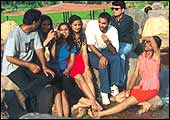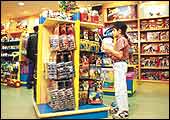|
 If
earlier sociologists like Max Weber and Louis Dumont maintained
that the social situation of the Brahmins was of decisive significance
to the understanding of the traditional social order in India, today
it is the changing fortunes of the backward classes that provides
the best insight into Indian society. It holds up a mirror that
reflects the turmoil of a society in transition. If
earlier sociologists like Max Weber and Louis Dumont maintained
that the social situation of the Brahmins was of decisive significance
to the understanding of the traditional social order in India, today
it is the changing fortunes of the backward classes that provides
the best insight into Indian society. It holds up a mirror that
reflects the turmoil of a society in transition.
For centuries, the backward classes-exploited,
oppressed and stigmatised-have been a part of India's submerged
humanity, confined to the fringes of society. Their social presence,
when not needed for specific tasks, was considered inconvenient
and embarrassing.
However, in the boiling environment of democratic
politics, the outward calm of the hierarchical society has been
shattered, releasing swirls and eddies of incalculable momentum
ensuring a major change in a society that no longer respects hierarchy
but one which demands equality-that too in a jiffy. And hence the
picture of a society marked by disorder, turbulence, and violence,
which is only likely to grow as society's constituents increase
their demands.
With religion and caste becoming a key determinant
of political identity, and strong caste-based affiliations an effective
tool for political mobilisation, the numerically-strong backward
classes have suddenly found themselves finding favour with the political
classes. With conflicts now even between scheduled castes and tribes,
expect to see more caste-related violence.
 |
|
The Spirituality
Question
God And Mammon:
God and business are unlikely to ever be separated in
India. Political and economic functions were always inferior
to religious functions in ancient India-and still are. With
individual businessmen, increasingly bereft of community-support
structures, recourse to religion cannot but increase. The
pursuit of wealth may be a secular enterprise, but its success,
will be governed by the divine.
|
But there are other disturbing chasms that are
only likely to widen in the future. The growing economic success
of some in India has created a wide chasm between the rich and the
poor, who make up nearly 65 per cent of the total population. Add
to this are more glaring facts: every third person in the world
without adequate drinking water is an Indian. More than 50 percent
of our people in cities live in degrading squalor, while about the
same number are unable to afford two square meals a day. A fourth
are illiterate. With little improvement in the conditions of this
section of the Indian population despite a decade of reforms, violence
may well become the order of the day. This is a bomb waiting to
explode. It's a tribute to the ordinary Indian and his stoicism
that it hasn't. Ashis Nandy, Senior Fellow, Centre for the Study
of Developing Societies, believes the ostentatious display of wealth
will lead to "enormous social tension", especially in
the urban areas. But rich, urban India won't be slowing down. They
will have better cellular phones and sleeker car models, more amusement
parks, more bowling alleys.
But there will be positives. There will be
a great flowering of creativity because liberalisation will necessary
empower some of those from the lower rungs of society. We are already
seeing the greater participation of women in the work force. There
is a great democracy of capital and opportunity unfolding for those
who rise above the ranks of the desperately poor. But they must
first have the ability to rise from the desperation, the tenacity
to survive inequalities. Tomorrow's society may be radically different.
Let's just hope our differences don't become too radical.
The Modern Indian Teenager
 |
|
Footloose: The contradiction just
got complex. Teens, in a perpetual identity crisis, now get
more with pais then with siblings.
|
You might think
today's teen is freer with the opposite sex. Possibly, unless it
interferes with career. Today's teenager wants greater intimacy
but is scared to get into relationship, because of the complexities
involved. The teenager is also very conscious of the fashion trends
and easily adopts to the changing trends. Role models are not paragons
of virtue but self-made millionairs-or billionaires in the case
of Bill Gates. Personal grooming is very important, not just to
appeal to the opposite sex but for personal satisfaction.
Finicky about careers-hence the importance
to education-and choosing comfort over conservatism and chic alike,
the Indian teenager is basically a group on roller skates, yet knows
where the sudden bend in the road leads. Moreover, they only want
the best in life-be it the shopping mall, life partner, or the latest
mp3-enabled music system. To most, computer literacy-if not proficiency-is
almost like what job-work skills were to their parents. In fact,
they were lucky to be waking up to the world when an economy-in-chains
was celebrating its new-found freedom a.k.a liberalisation.
No wonder then that for these, the all-consuming
philosophy is individualism. Teenagers also believe that they can
be principled without being bogged down by conservative tradition.
Surprises don't alarm them, they thrive on it. After all, it is
the hip, hep and happening generation.
But all these doesn't make them insulated from
the great Indian tradition of contradictions. Amidst the flash and
the cash, religion is still a big draw. Temples, mosques, churches,
and gurdwaras report more young people coming to worship than ever
before. It's a strange mingling of faith and consumerism, but it
is the way of the new Indian teenager.
-Ashish Gupta
The Modern Indian Child
 |
|
Fancy free: The biggest beneficiary
of post-liberalisation India. The new child is a marketer's
dream.
|
Being a kid was
never this fun before. For it, growing up today has become a natural
process accentuated by so many flashy thingamajigs-some even catering
to needs which no body believed existed before. Parents, who could
never even dream of such goodies during their infancy, are now showering
the latest toys on their kids, thanks to the new money.
Also, today's child is highly acquisitive-a
marketer's dream but a parent's nightmare. The flip side is that
she is also likely to be extremely spoilt. Wooden toys made by artisans
are out, battery-operated Taiwanese gizmos are in. And it wants
those products that offer instant joy and help identify with the
peer group.
Like the child of yesteryear, today's child
occupies a central position in terms of exercising power in the
family. It also has vaunting ambitions, of being rich and famous,
at a very young age. No longer do middle-class children say they
want to be steam-engine drivers or bus conductors; they are likely
instead to say they want to be Shah Rukh Khan or Sachin.
For parents, getting their kids to the best
school-not just educating them-has become a do-or-die affair. Yes,
growing up was never so much fun.
-Ashish Gupta
|

